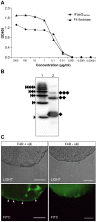Production of a subunit vaccine candidate against porcine post-weaning diarrhea in high-biomass transplastomic tobacco
- PMID: 22879967
- PMCID: PMC3411772
- DOI: 10.1371/journal.pone.0042405
Production of a subunit vaccine candidate against porcine post-weaning diarrhea in high-biomass transplastomic tobacco
Abstract
Post-weaning diarrhea (PWD) in piglets is a major problem in piggeries worldwide and results in severe economic losses. Infection with Enterotoxigenic Escherichia coli (ETEC) is the key culprit for the PWD disease. F4 fimbriae of ETEC are highly stable proteinaceous polymers, mainly composed of the major structural subunit FaeG, with a capacity to evoke mucosal immune responses, thus demonstrating a potential to act as an oral vaccine against ETEC-induced porcine PWD. In this study we used a transplastomic approach in tobacco to produce a recombinant variant of the FaeG protein, rFaeG(ntd/dsc), engineered for expression as a stable monomer by N-terminal deletion and donor strand-complementation (ntd/dsc). The generated transplastomic tobacco plants accumulated up to 2.0 g rFaeG(ntd/dsc) per 1 kg fresh leaf tissue (more than 1% of dry leaf tissue) and showed normal phenotype indistinguishable from wild type untransformed plants. We determined that chloroplast-produced rFaeG(ntd/dsc) protein retained the key properties of an oral vaccine, i.e. binding to porcine intestinal F4 receptors (F4R), and inhibition of the F4-possessing (F4+) ETEC attachment to F4R. Additionally, the plant biomass matrix was shown to delay degradation of the chloroplast-produced rFaeG(ntd/dsc) in gastrointestinal conditions, demonstrating a potential to function as a shelter-vehicle for vaccine delivery. These results suggest that transplastomic plants expressing the rFaeG(ntd/dsc) protein could be used for production and, possibly, delivery of an oral vaccine against porcine F4+ ETEC infections. Our findings therefore present a feasible approach for developing an oral vaccination strategy against porcine PWD.
Conflict of interest statement
Figures








Similar articles
-
Heterologous prime-boost immunization of two-component vaccine candidate PWDVax protected pigs against F18 enterotoxigenic Escherichia coli post-weaning diarrhea.Infect Immun. 2025 Apr 8;93(4):e0040624. doi: 10.1128/iai.00406-24. Epub 2025 Mar 12. Infect Immun. 2025. PMID: 40071919 Free PMC article.
-
Binding of a monoclonal antibody positively correlates with bioactivity of the F4 fimbrial adhesin FaeG associated with post-weaning diarrhoea in piglets.J Immunol Methods. 2004 Nov;294(1-2):81-8. doi: 10.1016/j.jim.2004.08.007. J Immunol Methods. 2004. PMID: 15604018
-
Application of a Novel Epitope- and Structure-Based Vaccinology-Assisted Fimbria-Toxin Multiepitope Fusion Antigen of Enterotoxigenic Escherichia coli for Development of Multivalent Vaccines against Porcine Postweaning Diarrhea.Appl Environ Microbiol. 2020 Nov 24;86(24):e00274-20. doi: 10.1128/AEM.00274-20. Print 2020 Nov 24. Appl Environ Microbiol. 2020. PMID: 32144103 Free PMC article.
-
ETEC vaccination in pigs.Vet Immunol Immunopathol. 2013 Mar 15;152(1-2):37-42. doi: 10.1016/j.vetimm.2012.09.024. Epub 2012 Sep 26. Vet Immunol Immunopathol. 2013. PMID: 23068270 Review.
-
Receptor for the F4 fimbriae of enterotoxigenic Escherichia coli (ETEC).Appl Microbiol Biotechnol. 2015 Jun;99(12):4953-9. doi: 10.1007/s00253-015-6643-9. Epub 2015 May 13. Appl Microbiol Biotechnol. 2015. PMID: 25967654 Review.
Cited by
-
Plant-Produced Vaccines: Future Applications in Aquaculture.Front Plant Sci. 2021 Aug 12;12:718775. doi: 10.3389/fpls.2021.718775. eCollection 2021. Front Plant Sci. 2021. PMID: 34456958 Free PMC article. Review.
-
Expression of a Codon-Optimized dsdA Gene in Tobacco Plastids and Rice Nucleus Confers D-Serine Tolerance.Front Plant Sci. 2016 May 12;7:640. doi: 10.3389/fpls.2016.00640. eCollection 2016. Front Plant Sci. 2016. PMID: 27242842 Free PMC article.
-
Expression of the Multimeric and Highly Immunogenic Brucella spp. Lumazine Synthase Fused to Bovine Rotavirus VP8d as a Scaffold for Antigen Production in Tobacco Chloroplasts.Front Plant Sci. 2015 Dec 23;6:1170. doi: 10.3389/fpls.2015.01170. eCollection 2015. Front Plant Sci. 2015. PMID: 26779198 Free PMC article.
-
Elastin-like polypeptides as a promising family of genetically-engineered protein based polymers.World J Microbiol Biotechnol. 2014 Aug;30(8):2141-52. doi: 10.1007/s11274-014-1649-5. Epub 2014 Apr 4. World J Microbiol Biotechnol. 2014. PMID: 24699809 Free PMC article. Review.
-
The increasing value of plant-made proteins.Curr Opin Biotechnol. 2015 Apr;32:163-170. doi: 10.1016/j.copbio.2014.12.008. Epub 2015 Jan 15. Curr Opin Biotechnol. 2015. PMID: 25578557 Free PMC article. Review.
References
-
- Fairbrother JM, Nadeau E, Gyles CL (2005) Escherichia coli in postweaning diarrhea in pigs: an update on bacterial types, pathogenesis, and prevention strategies. Anim Health Res Rev 6: 17–39. - PubMed
-
- Hampson DJ (1994) Postweaning Escherichia coli diarrhoea in pigs. In: Gyles CL, editor. Escherichia coli in domestic animals and humans. Wallingford: CAB International. 171–191.
-
- Bertschinger HU, Fairbrother JM (1999) Escherichia coli infections. In: Straw BE, D’Allaire S, Mengeling WL, Taylor DJ, editors. Diseases of Swine, 8th Edition. Iowa: Iowa State University Press. 431–454.
-
- Ciosek D, Truszczynski M, Jagodzinski M (1983) The effectiveness of inactivated vaccines applied parenterally to sows to control Escherichia coli diarrhea in piglets in an industrial fattening farm. Comp Immunol Microbiol Infect Dis 6: 313–319. - PubMed
Publication types
MeSH terms
Substances
LinkOut - more resources
Full Text Sources
Other Literature Sources
Medical

